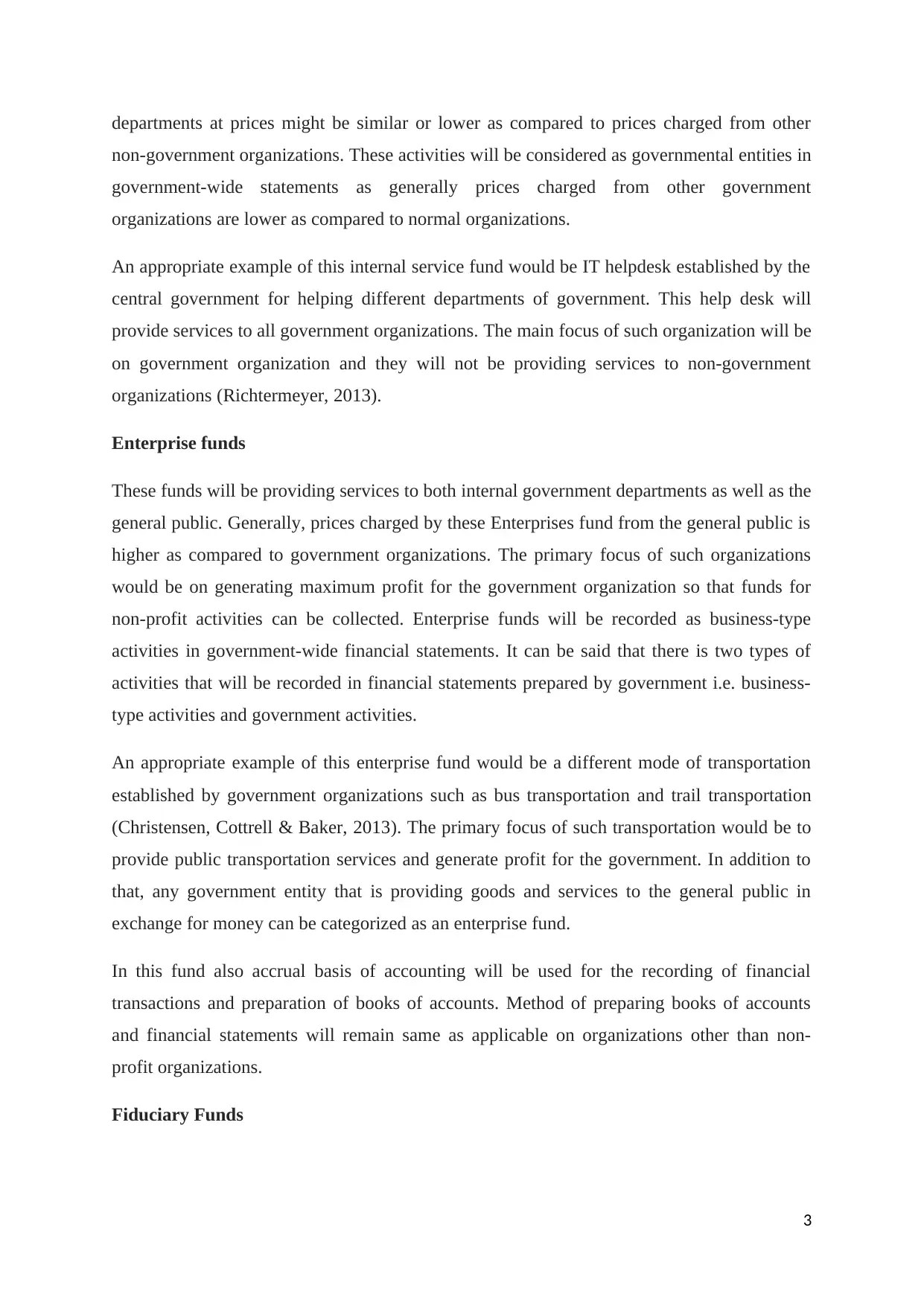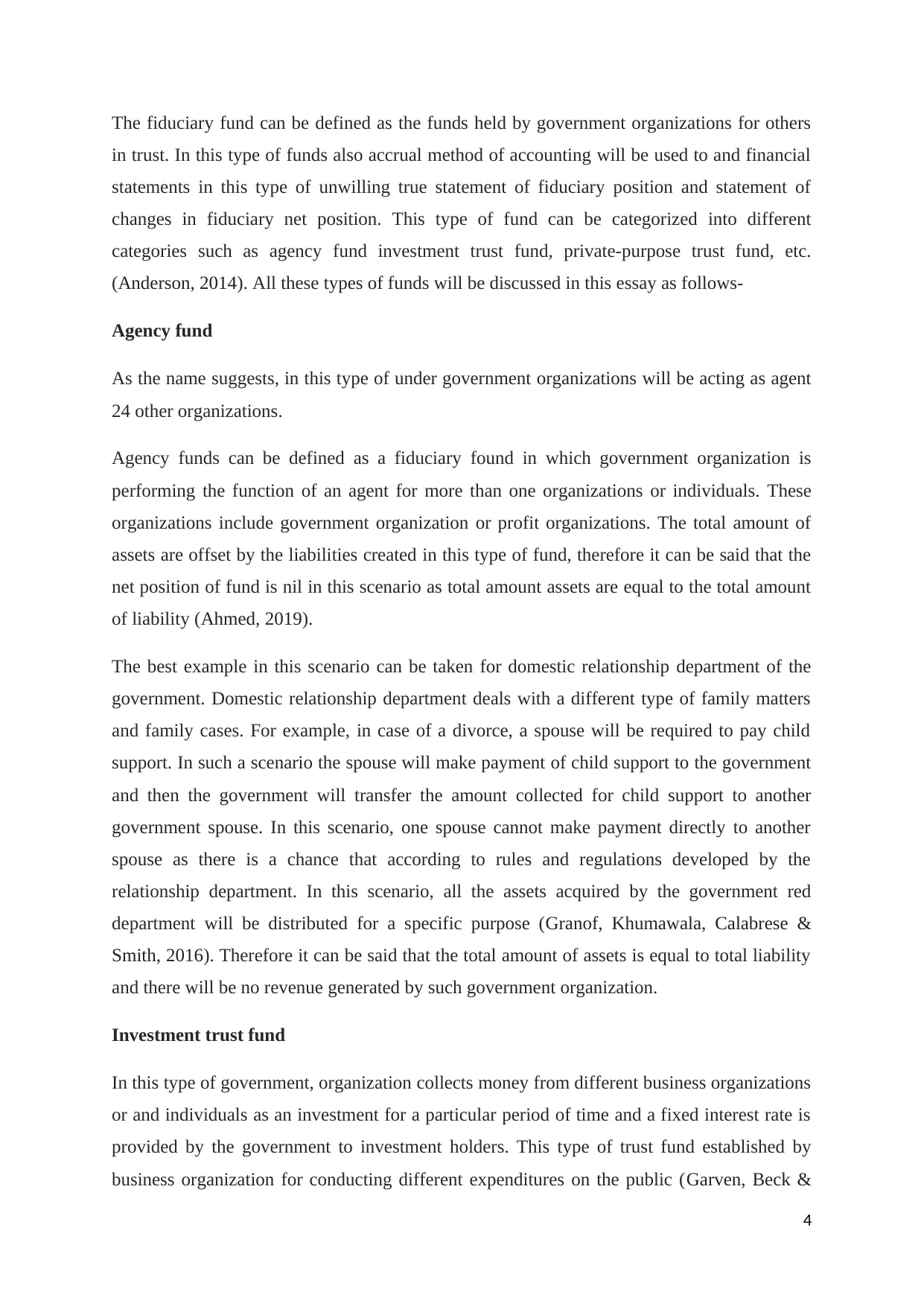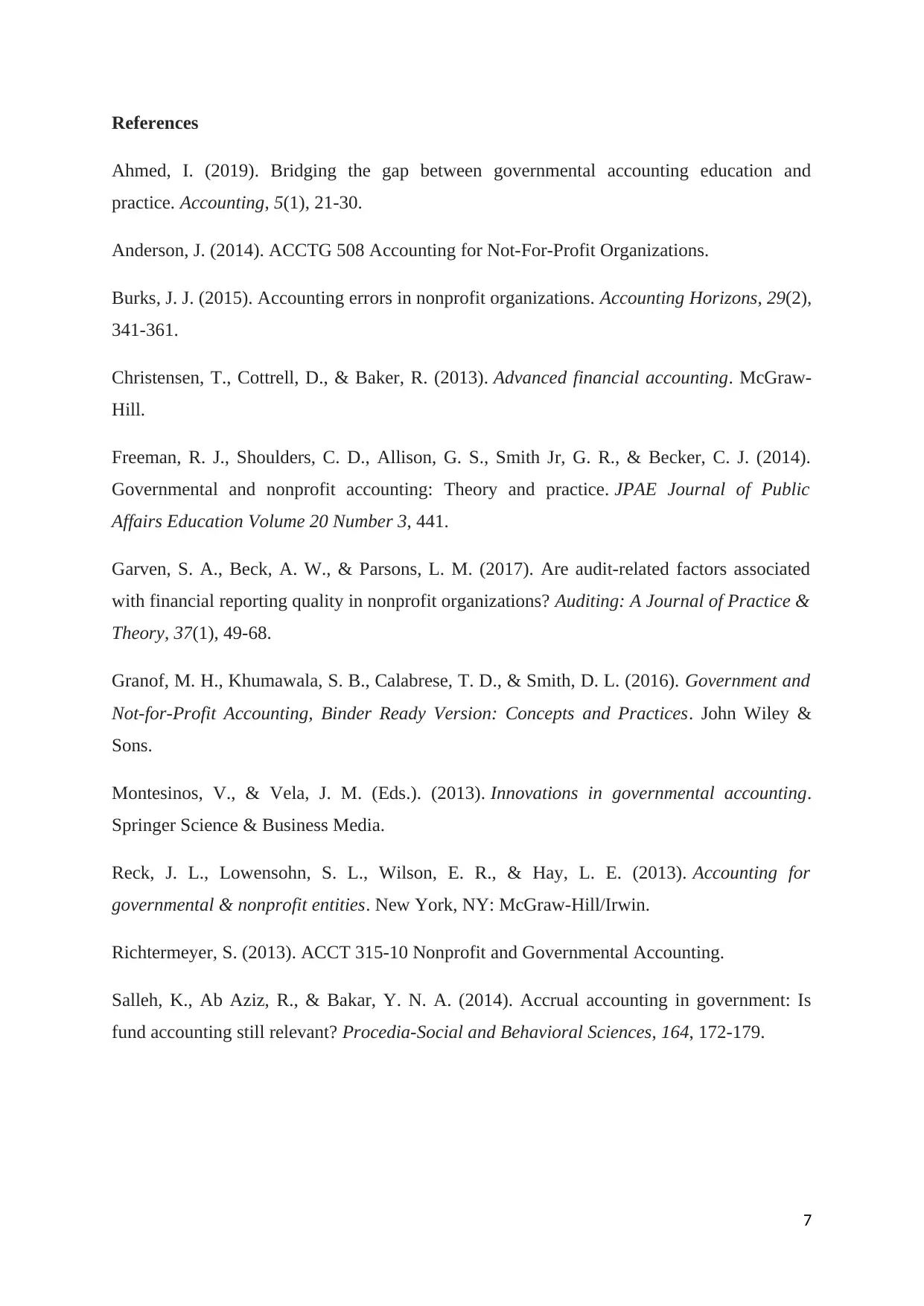Understanding Proprietary Funds: A Government Accounting Perspective
VerifiedAdded on 2023/03/29
|7
|1831
|94
Essay
AI Summary
This essay provides a detailed overview of proprietary fund accounting within government organizations, contrasting it with other fund types like internal service, enterprise, and fiduciary funds. It explains the accrual method used in proprietary funds, categorizing them into internal service and enterprise funds, highlighting their distinct functions and accounting practices. The essay also delves into fiduciary funds, including agency, investment trust, and private-purpose trust funds, emphasizing the government's role as an agent. It concludes that while all these funds use accrual accounting, their financial transactions are separate from government-wide statements due to the government's fiduciary role. Desklib offers a platform to explore more solved assignments and study tools for similar topics.

Government Accounting
1
1
Paraphrase This Document
Need a fresh take? Get an instant paraphrase of this document with our AI Paraphraser

Introduction
Business undertaken by a government organization can be divided into different forms on the
basis of their characteristics such as government fund proprietary fund and fiduciary refund.
Accounting for all these types of funds are different from each other. The proprietary fund
can be defined as the business undertaken by the business organization that is treated as a for-
profit business. It can be said that two main focus on these funds is earning profit for the
government by providing product and services to customer i.e. the general public. An
appropriate example of a proprietary fund can be Airport Authority established by the
government that is working as government Agencies and charging money for providing
services to customers (Reck, Lowensohn, Wilson & Hay, 2013). Main focus of this essay
would be on proprietary fund accounting.
Proprietary fund
For the purpose of accounting, the accrual method of accounting is used in the preparation of
financial account as well as books of accounts. All the assets and liabilities in this
organization will be recorded as a business organization operating in a normal market. As this
fund is using the accrual method of accounting, therefore all the assets and liabilities will be
recorded in the balance sheet and expenses will be recorded rather than expenditures.
Propriety fund in government accounting can be categorized into two major categories i.e.
internal service fund and enterprise fund.
Internal service fund
Internal service fund can be defined as the business activities that are undertaken for
providing goods and services to other departments of government. This type of services will
include goods and services provided to other departments of the same government. It will
also include goods and services provided to other governments. For example, if one branch of
Central Government providing goods and services to other Branch of Central Government
then it will be categorized as an internal service fund. In addition to that if one Branch of
Central government is providing goods and services to state government organizations then it
will also be categorized as an internal service fund.
In this type of transaction, all the accounting principles and concepts will be applicable to
government organizations as other business organizations operating for profit (Salleh, Ab
Aziz & Bakar, 2014). In addition to that goods and services will be provided to government
2
Business undertaken by a government organization can be divided into different forms on the
basis of their characteristics such as government fund proprietary fund and fiduciary refund.
Accounting for all these types of funds are different from each other. The proprietary fund
can be defined as the business undertaken by the business organization that is treated as a for-
profit business. It can be said that two main focus on these funds is earning profit for the
government by providing product and services to customer i.e. the general public. An
appropriate example of a proprietary fund can be Airport Authority established by the
government that is working as government Agencies and charging money for providing
services to customers (Reck, Lowensohn, Wilson & Hay, 2013). Main focus of this essay
would be on proprietary fund accounting.
Proprietary fund
For the purpose of accounting, the accrual method of accounting is used in the preparation of
financial account as well as books of accounts. All the assets and liabilities in this
organization will be recorded as a business organization operating in a normal market. As this
fund is using the accrual method of accounting, therefore all the assets and liabilities will be
recorded in the balance sheet and expenses will be recorded rather than expenditures.
Propriety fund in government accounting can be categorized into two major categories i.e.
internal service fund and enterprise fund.
Internal service fund
Internal service fund can be defined as the business activities that are undertaken for
providing goods and services to other departments of government. This type of services will
include goods and services provided to other departments of the same government. It will
also include goods and services provided to other governments. For example, if one branch of
Central Government providing goods and services to other Branch of Central Government
then it will be categorized as an internal service fund. In addition to that if one Branch of
Central government is providing goods and services to state government organizations then it
will also be categorized as an internal service fund.
In this type of transaction, all the accounting principles and concepts will be applicable to
government organizations as other business organizations operating for profit (Salleh, Ab
Aziz & Bakar, 2014). In addition to that goods and services will be provided to government
2

departments at prices might be similar or lower as compared to prices charged from other
non-government organizations. These activities will be considered as governmental entities in
government-wide statements as generally prices charged from other government
organizations are lower as compared to normal organizations.
An appropriate example of this internal service fund would be IT helpdesk established by the
central government for helping different departments of government. This help desk will
provide services to all government organizations. The main focus of such organization will be
on government organization and they will not be providing services to non-government
organizations (Richtermeyer, 2013).
Enterprise funds
These funds will be providing services to both internal government departments as well as the
general public. Generally, prices charged by these Enterprises fund from the general public is
higher as compared to government organizations. The primary focus of such organizations
would be on generating maximum profit for the government organization so that funds for
non-profit activities can be collected. Enterprise funds will be recorded as business-type
activities in government-wide financial statements. It can be said that there is two types of
activities that will be recorded in financial statements prepared by government i.e. business-
type activities and government activities.
An appropriate example of this enterprise fund would be a different mode of transportation
established by government organizations such as bus transportation and trail transportation
(Christensen, Cottrell & Baker, 2013). The primary focus of such transportation would be to
provide public transportation services and generate profit for the government. In addition to
that, any government entity that is providing goods and services to the general public in
exchange for money can be categorized as an enterprise fund.
In this fund also accrual basis of accounting will be used for the recording of financial
transactions and preparation of books of accounts. Method of preparing books of accounts
and financial statements will remain same as applicable on organizations other than non-
profit organizations.
Fiduciary Funds
3
non-government organizations. These activities will be considered as governmental entities in
government-wide statements as generally prices charged from other government
organizations are lower as compared to normal organizations.
An appropriate example of this internal service fund would be IT helpdesk established by the
central government for helping different departments of government. This help desk will
provide services to all government organizations. The main focus of such organization will be
on government organization and they will not be providing services to non-government
organizations (Richtermeyer, 2013).
Enterprise funds
These funds will be providing services to both internal government departments as well as the
general public. Generally, prices charged by these Enterprises fund from the general public is
higher as compared to government organizations. The primary focus of such organizations
would be on generating maximum profit for the government organization so that funds for
non-profit activities can be collected. Enterprise funds will be recorded as business-type
activities in government-wide financial statements. It can be said that there is two types of
activities that will be recorded in financial statements prepared by government i.e. business-
type activities and government activities.
An appropriate example of this enterprise fund would be a different mode of transportation
established by government organizations such as bus transportation and trail transportation
(Christensen, Cottrell & Baker, 2013). The primary focus of such transportation would be to
provide public transportation services and generate profit for the government. In addition to
that, any government entity that is providing goods and services to the general public in
exchange for money can be categorized as an enterprise fund.
In this fund also accrual basis of accounting will be used for the recording of financial
transactions and preparation of books of accounts. Method of preparing books of accounts
and financial statements will remain same as applicable on organizations other than non-
profit organizations.
Fiduciary Funds
3
⊘ This is a preview!⊘
Do you want full access?
Subscribe today to unlock all pages.

Trusted by 1+ million students worldwide

The fiduciary fund can be defined as the funds held by government organizations for others
in trust. In this type of funds also accrual method of accounting will be used to and financial
statements in this type of unwilling true statement of fiduciary position and statement of
changes in fiduciary net position. This type of fund can be categorized into different
categories such as agency fund investment trust fund, private-purpose trust fund, etc.
(Anderson, 2014). All these types of funds will be discussed in this essay as follows-
Agency fund
As the name suggests, in this type of under government organizations will be acting as agent
24 other organizations.
Agency funds can be defined as a fiduciary found in which government organization is
performing the function of an agent for more than one organizations or individuals. These
organizations include government organization or profit organizations. The total amount of
assets are offset by the liabilities created in this type of fund, therefore it can be said that the
net position of fund is nil in this scenario as total amount assets are equal to the total amount
of liability (Ahmed, 2019).
The best example in this scenario can be taken for domestic relationship department of the
government. Domestic relationship department deals with a different type of family matters
and family cases. For example, in case of a divorce, a spouse will be required to pay child
support. In such a scenario the spouse will make payment of child support to the government
and then the government will transfer the amount collected for child support to another
government spouse. In this scenario, one spouse cannot make payment directly to another
spouse as there is a chance that according to rules and regulations developed by the
relationship department. In this scenario, all the assets acquired by the government red
department will be distributed for a specific purpose (Granof, Khumawala, Calabrese &
Smith, 2016). Therefore it can be said that the total amount of assets is equal to total liability
and there will be no revenue generated by such government organization.
Investment trust fund
In this type of government, organization collects money from different business organizations
or and individuals as an investment for a particular period of time and a fixed interest rate is
provided by the government to investment holders. This type of trust fund established by
business organization for conducting different expenditures on the public (Garven, Beck &
4
in trust. In this type of funds also accrual method of accounting will be used to and financial
statements in this type of unwilling true statement of fiduciary position and statement of
changes in fiduciary net position. This type of fund can be categorized into different
categories such as agency fund investment trust fund, private-purpose trust fund, etc.
(Anderson, 2014). All these types of funds will be discussed in this essay as follows-
Agency fund
As the name suggests, in this type of under government organizations will be acting as agent
24 other organizations.
Agency funds can be defined as a fiduciary found in which government organization is
performing the function of an agent for more than one organizations or individuals. These
organizations include government organization or profit organizations. The total amount of
assets are offset by the liabilities created in this type of fund, therefore it can be said that the
net position of fund is nil in this scenario as total amount assets are equal to the total amount
of liability (Ahmed, 2019).
The best example in this scenario can be taken for domestic relationship department of the
government. Domestic relationship department deals with a different type of family matters
and family cases. For example, in case of a divorce, a spouse will be required to pay child
support. In such a scenario the spouse will make payment of child support to the government
and then the government will transfer the amount collected for child support to another
government spouse. In this scenario, one spouse cannot make payment directly to another
spouse as there is a chance that according to rules and regulations developed by the
relationship department. In this scenario, all the assets acquired by the government red
department will be distributed for a specific purpose (Granof, Khumawala, Calabrese &
Smith, 2016). Therefore it can be said that the total amount of assets is equal to total liability
and there will be no revenue generated by such government organization.
Investment trust fund
In this type of government, organization collects money from different business organizations
or and individuals as an investment for a particular period of time and a fixed interest rate is
provided by the government to investment holders. This type of trust fund established by
business organization for conducting different expenditures on the public (Garven, Beck &
4
Paraphrase This Document
Need a fresh take? Get an instant paraphrase of this document with our AI Paraphraser

Parsons, 2017). Bonds issued by the government is one of the most appropriate examples of
the investment trust fund. If the government is in requirement of immediate cash for specific
purposes such as the construction of highway then they will issue these bonds to the general
public in exchange for a fixed interest rate. With the help of these bonds, they can acquire
funding for projects at a lower cost as compared to cost to that would have incurred in case of
funding from private banking organizations.
Investment Pools
Investment pools is also a type of Trust established by a government organization. In this
type of trust, different government organizations and departments form a trust for pooling all
the extra cash available with them for the purpose of earning additional income. These idle
money invested in different securities for the generation of revenue and such revenue is
divided among in accordance with the proportion of investment made by different
government organizations. In this type of trust, generally, investment is made with the help of
investment manager such as a treasurer or investment banking companies that have expert
knowledge in relation to risk and return on different investments (Freeman, Shoulders,
Allison, Smith Jr & Becker, 2014).
Investment pools can also be divided into two categories i.e. internal investment pool and
external investment pool. If participating government organizations and departments are
related to the same government then it will be categorized as internal investment pool
whereas if such organizations are from the different governments then it will be categorized
as external investment pool (Montesinos & Vela, 2013). All the interest earned by this
investment pool trust will be disclosed as revenue generated by the trust.
Private purpose funds
Any type of fund established by government organizations rather than pension and
investment fund will be categorized as private purpose trust. For example, if a citizen of the
country has made a donation to government organization for the establishment of any
building, library, sports center etc. then such amount will be deposited in private purpose
trust. In this scenario, government will act as an agent of such citizen for the development of
a particular building. In this scenario the accounting process will be identical to the
accounting process undertaken in case of an enterprise fund (Burks, 2015).
Conclusion
5
the investment trust fund. If the government is in requirement of immediate cash for specific
purposes such as the construction of highway then they will issue these bonds to the general
public in exchange for a fixed interest rate. With the help of these bonds, they can acquire
funding for projects at a lower cost as compared to cost to that would have incurred in case of
funding from private banking organizations.
Investment Pools
Investment pools is also a type of Trust established by a government organization. In this
type of trust, different government organizations and departments form a trust for pooling all
the extra cash available with them for the purpose of earning additional income. These idle
money invested in different securities for the generation of revenue and such revenue is
divided among in accordance with the proportion of investment made by different
government organizations. In this type of trust, generally, investment is made with the help of
investment manager such as a treasurer or investment banking companies that have expert
knowledge in relation to risk and return on different investments (Freeman, Shoulders,
Allison, Smith Jr & Becker, 2014).
Investment pools can also be divided into two categories i.e. internal investment pool and
external investment pool. If participating government organizations and departments are
related to the same government then it will be categorized as internal investment pool
whereas if such organizations are from the different governments then it will be categorized
as external investment pool (Montesinos & Vela, 2013). All the interest earned by this
investment pool trust will be disclosed as revenue generated by the trust.
Private purpose funds
Any type of fund established by government organizations rather than pension and
investment fund will be categorized as private purpose trust. For example, if a citizen of the
country has made a donation to government organization for the establishment of any
building, library, sports center etc. then such amount will be deposited in private purpose
trust. In this scenario, government will act as an agent of such citizen for the development of
a particular building. In this scenario the accounting process will be identical to the
accounting process undertaken in case of an enterprise fund (Burks, 2015).
Conclusion
5

After analysing different type of trust funds it can be said that to all of these funds will follow
the accrual basis of accounting. In addition to that as the government is acting as an agent,
therefore financial transactions in case of trusts will not be a part of government-wide
financial statements. Separate financial statements will be prepared for different funds
represented by the government organizations. This is due to the fact that the government is
only acting as an agent and the money received in the trust is not owned by the government.
Representation of such money in government-wide financial statement would be misleading.
6
the accrual basis of accounting. In addition to that as the government is acting as an agent,
therefore financial transactions in case of trusts will not be a part of government-wide
financial statements. Separate financial statements will be prepared for different funds
represented by the government organizations. This is due to the fact that the government is
only acting as an agent and the money received in the trust is not owned by the government.
Representation of such money in government-wide financial statement would be misleading.
6
⊘ This is a preview!⊘
Do you want full access?
Subscribe today to unlock all pages.

Trusted by 1+ million students worldwide

References
Ahmed, I. (2019). Bridging the gap between governmental accounting education and
practice. Accounting, 5(1), 21-30.
Anderson, J. (2014). ACCTG 508 Accounting for Not-For-Profit Organizations.
Burks, J. J. (2015). Accounting errors in nonprofit organizations. Accounting Horizons, 29(2),
341-361.
Christensen, T., Cottrell, D., & Baker, R. (2013). Advanced financial accounting. McGraw-
Hill.
Freeman, R. J., Shoulders, C. D., Allison, G. S., Smith Jr, G. R., & Becker, C. J. (2014).
Governmental and nonprofit accounting: Theory and practice. JPAE Journal of Public
Affairs Education Volume 20 Number 3, 441.
Garven, S. A., Beck, A. W., & Parsons, L. M. (2017). Are audit-related factors associated
with financial reporting quality in nonprofit organizations? Auditing: A Journal of Practice &
Theory, 37(1), 49-68.
Granof, M. H., Khumawala, S. B., Calabrese, T. D., & Smith, D. L. (2016). Government and
Not-for-Profit Accounting, Binder Ready Version: Concepts and Practices. John Wiley &
Sons.
Montesinos, V., & Vela, J. M. (Eds.). (2013). Innovations in governmental accounting.
Springer Science & Business Media.
Reck, J. L., Lowensohn, S. L., Wilson, E. R., & Hay, L. E. (2013). Accounting for
governmental & nonprofit entities. New York, NY: McGraw-Hill/Irwin.
Richtermeyer, S. (2013). ACCT 315-10 Nonprofit and Governmental Accounting.
Salleh, K., Ab Aziz, R., & Bakar, Y. N. A. (2014). Accrual accounting in government: Is
fund accounting still relevant? Procedia-Social and Behavioral Sciences, 164, 172-179.
7
Ahmed, I. (2019). Bridging the gap between governmental accounting education and
practice. Accounting, 5(1), 21-30.
Anderson, J. (2014). ACCTG 508 Accounting for Not-For-Profit Organizations.
Burks, J. J. (2015). Accounting errors in nonprofit organizations. Accounting Horizons, 29(2),
341-361.
Christensen, T., Cottrell, D., & Baker, R. (2013). Advanced financial accounting. McGraw-
Hill.
Freeman, R. J., Shoulders, C. D., Allison, G. S., Smith Jr, G. R., & Becker, C. J. (2014).
Governmental and nonprofit accounting: Theory and practice. JPAE Journal of Public
Affairs Education Volume 20 Number 3, 441.
Garven, S. A., Beck, A. W., & Parsons, L. M. (2017). Are audit-related factors associated
with financial reporting quality in nonprofit organizations? Auditing: A Journal of Practice &
Theory, 37(1), 49-68.
Granof, M. H., Khumawala, S. B., Calabrese, T. D., & Smith, D. L. (2016). Government and
Not-for-Profit Accounting, Binder Ready Version: Concepts and Practices. John Wiley &
Sons.
Montesinos, V., & Vela, J. M. (Eds.). (2013). Innovations in governmental accounting.
Springer Science & Business Media.
Reck, J. L., Lowensohn, S. L., Wilson, E. R., & Hay, L. E. (2013). Accounting for
governmental & nonprofit entities. New York, NY: McGraw-Hill/Irwin.
Richtermeyer, S. (2013). ACCT 315-10 Nonprofit and Governmental Accounting.
Salleh, K., Ab Aziz, R., & Bakar, Y. N. A. (2014). Accrual accounting in government: Is
fund accounting still relevant? Procedia-Social and Behavioral Sciences, 164, 172-179.
7
1 out of 7